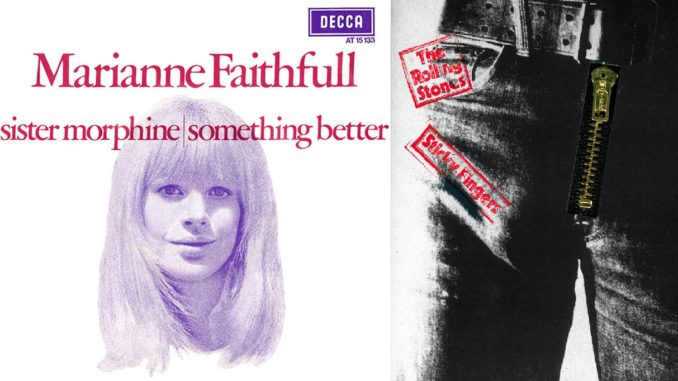
This classic tale of waking up after overdosing was initially recorded before Mick Taylor had joined the band. Mick Jagger wrote its ominous chord progression back in early 1968 during a holiday in Italy with Marianne Faithfull. The pair then went on to write some of its lyrics together.
The very first attempt of the song that exists stems from the Rolling Stones’ Beggars Banquet sessions at Olympic Sound studios in London, which started on 13 May 1968 and stretched into June. The only guest musician on that attempt is Nicky Hopkins (piano), meaning the iconic slide guitar of Ry Cooder as well as Jack Nitzsche’s discordant piano contributions are not yet part of the song. This original take also has a few different lyrics as Jagger was still experimenting with their final form.
The Stones did not end up using the track, which meant there was a green light for Faithfull to release her own version. This was attempted the month after the wrap-up of the Beggar’s Banquet sessions at LA’s Electra Studios in July 1968. Jagger sang on the initial sessions, which now included Jack Nitzsche on piano, Ry Cooder on slide guitar, and Charlie Watts on drums. Marianne Faithfull would then sing in place of Jagger’s guide vocal.
The track was released as Faithfull’s next single along with Something Better on 21 February 1969. It wasn’t available for long. The single would be banned and withdrawn from circulation by her record label shortly afterwards due to the drug reference in the title.
The song would eventually see release on compilation albums years later. But by then, the world would know it as a Rolling Stones song. They had recorded a new version and included it on their Sticky Fingers album, released 23 April 1971.
Mick Jagger knew the song was too good to waste, and wondered if perhaps the clout of a huge band like The Rolling Stones would see it through – if not as a single, then perhaps as an album track, where it was less in people’s face than as a featured single.
When Nitzsche and Cooder were in London in March 1969 to work on the soundtrack of the movie Performance, where Mich Jagger has the starring role as well as contributing music, Jagger invited them to record it with the Stones at Olympic Studios. He wanted them to be part of a new attempt at Sister Morphine.
This session yielded magical results. The full potential of the song was finally unlocked. Faithfull’s version of the song from the initial Elektra sessions was felt to have been restrained and somewhat tentative. The new attempt at Olympic studios managed to summon up an eerie sense of dislocation that suited the song’s subject matter to perfection. It felt dangerous.
The Stones’ version features Mick Jagger on vocals, Keith Richards on acoustic guitar and backing vocals, Ry Cooder (slide guitar), Jack Nitzsche (electric piano), Bill Wyman on bass and Charlie Watts once again on drums.
“It’s about a man after an accident, really,” Jagger revealed many years later. The nature of the accident is not 100% conclusive from the song, whether accidentally overdosing (the popular belief) or if the person has gone through some other accident and is craving drugs for the pain.
The scream of the ambulance is sounding in my ears
Tell me, Sister Morphine, how long have I been lying here?
What am I doing in this place?
Why does the doctor have no face?
Oh, I can’t crawl across the floor
Ah, can’t you see, Sister Morphine, I’m trying to score
In any case, the person in the song is clearly no stranger to the numbness that drugs can give, but seem to be craving more than that numbness.
Some lines are downright chilling and say a lot about the state of the mind of the person in the song.
Please, Sister Morphine, turn my nightmares into dreams
Oh, can’t you see I’m fading fast?
And that this shot will be my last
Faithfull was not a heavy drug user when she wrote the lyrics, but became an addict in 1971 at the same time that The Stones’ version was released. She called this song her “Frankenstein,” consuming her and leading her into an abyss of drugs. In later years, she was able to break the habit and resume a successful career as both a singer and an actress.
Marianne Faithfull recalled writing the song in an interview with The Guardian newspaper in January 2013: “I just liked the name, and loved Lou Reed’s work, Sister Ray and Heroin. I liked the idea poetically. I thought it was like Baudelaire, but the song doesn’t glamorise anything. It was a really interesting vision.”
The writing credits for the song would be the cause of some squabble. Faithfull initially got a writing credit on this song along with Jagger/Richards for the release of her own original UK Decca single, but when London Records issued the single in the US, her name was omitted, as it was from the credit on Sticky Fingers.
After a legal battle Faithfull retained her rights as a co-author, acknowledged by the 1994 Virgin Records reissue of the Stones album catalogue from Sticky Fingers through Steel Wheels. This gave Faithfull something the three other Stones had struggled to get, but probably deserved from time to time: a writing credit on a Rolling Stones song. It also shows the hoops that had to be jumped through to get this, even in a case like this which should have been relatively straightforward.
Sticky Fingers is considered one of the Stones’ best albums. Sister Morphine highlights one of several reasons why: Jagger refused to let commercial considerations tone down his lyrics. On this particular song, the help he had from Faithfull should not be underestimated.

Facebook Comments